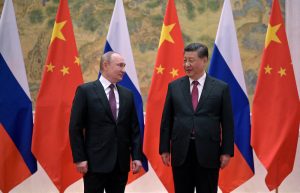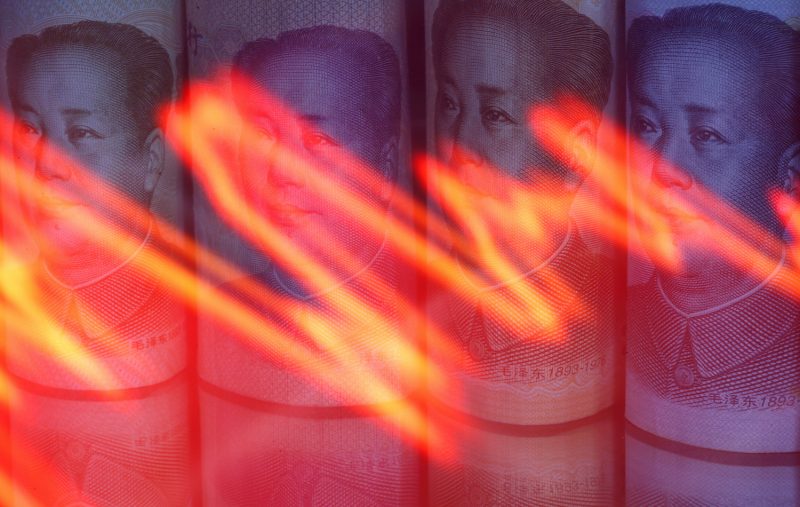Russia’s invasion of Ukraine has been a disaster for many companies in both of those countries, as well as lot of others in Europe. But some companies have also been winners from impacts caused by the war.
Chinese entrepreneur Wang Min, who has an LED lights company in southern Guangdong province, is one whose business has gained, and partly because Moscow has embraced the yuan.
The fact that Russian customers can now pay him in yuan – rather than dollars or euros, is a “win-win”, he says.
Wang’s plans have been transformed by the conflict in Ukraine and the subsequent Western sanctions on Moscow that shut Russia’s banks and many of its companies out of the dollar and euro payment systems.
His contract manufacturing business with Russia was small in the past, but now he’s preparing to invest in warehousing there.
“We hope that next year sales in Russia can account for 10-15% of our total sales,” said the businessman, whose annual revenue of about $20 million mainly comes from Africa and South America.
Wang is seeking to capitalise on a rapid “yuanisation” of Russia’s economy this year as the isolated country seeks financial security from Asian powerhouse China. He sees a win-win situation in Chinese exporters reducing their currency risks and payment becoming more convenient for Russian buyers.
ALSO SEE:
China Stocks Rebound on Hopes of Quicker Covid Loosening
Yuan-Rouble Trade Skyrockets
While the yuan, or renminbi, has been making gradual inroads into Russia for years, the crawl has turned into a sprint in the past nine months as the currency has swept into the country’s markets and trade flows, according to a review of data and interviews with 10 business and finance players.
Russia’s financial shift eastwards could boost cross-border commerce, present a growing economic counterweight to the dollar and limit Western efforts to pressure Moscow by economic means.
Total transactions in the yuan-rouble pair on the Moscow Exchange ballooned to an average of almost 9 billion yuan ($1.25 billion) a day last month, exchange data showed. Previously, they rarely exceeded 1 billion yuan in an entire week.
“What happened was that it became suddenly very risky and expensive to keep traditional currencies – dollar, euro, British pounds,” said Andrei Akopian, managing director of Moscow-based investment firm Caderus Capital, citing the potential danger of a bank that keeps foreign currency deposits being sanctioned.
“Everybody was motivated and even pushed towards the rouble or other currencies including, and first of all, the renminbi.”
Indeed, yuan-rouble trading totalled 185 billion yuan in October, more than 80 times the level seen in February when Russia launched what it refers to as a “special military operation” in Ukraine near the end of the month, according to exchange data.
The surge of interest has seen the yuan’s share of the currency market jump to 40-45% from less than 1% at the start of the year, said Dmitry Piskulov, international projects head at the Moscow Exchange’s foreign-exchange market department.
By comparison, the dollar/rouble pair, which commanded more than 80% of trading volumes on the Russian market in January, has seen its share drop to about 40% as of October, according to exchange data and the central bank.
Joining the Yuan Train
International money flows reflect a similar trend. Until April, Russia didn’t even make the top 15 list of countries using the yuan outside mainland China, in terms of the value of inbound and outbound flows, according to data from global financial networking system SWIFT.
It has since jumped to No-4, lagging only Hong Kong, the city’s former colonial ruler Britain and Singapore.
To put this in a global context, though, the dollar and euro are still by far the dominant currencies, representing more than 42% and 35% of flows respectively as of September this year. The yuan has risen to almost 2.5% from below 2% two years earlier.
Wang’s business optimism is echoed by Shen Muhui, who heads a trade group for small exporters to Russia in neighbouring Fujian province. He said more and more Russian buyers were opening yuan accounts and settling transactions directly in the Chinese currency, which he said was a big advantage.
“The Russia-Ukraine conflict has brought opportunities for Chinese businessmen,” said Shen, adding that his association had received many inquiries from Chinese companies interested in doing business in Russia.
It’s not only Chinese companies, or small companies, joining the yuan train.
Seven Russian corporate giants, including Rusal, Rosneft and Polyus, have raised a total of 42 billion yuan in bonds on the Russian market, according to Reuters calculations, and the list could grow with No-1 lender Sberbank and oil firm Gazpromneft saying they’re also considering renminbi debt.
Aluminium producer Rusal, which buys raw materials from China and then sells a large chunk of its finished goods there, said it had stepped up the share of yuan used in those purchases and sales this year, and that the share would continue to rise, though it declined to provide a detailed breakdown.

Russia-China Partnership
While President Vladimir Putin has long sought to reduce Russia’s reliance on the dollar, geopolitics has turbo-charged this trend in 2022.
China, the world’s No-2 economy, is the biggest global power not to join economic sanctions against Russia. Indeed, Putin and Chinese President Xi Jinping sealed a “no limits” partnership in February, weeks before Moscow launched its invasion.
The yuan comprised about 19% of Russia’s trade settlements with China in 2021 versus the dollar’s 49% share, Andrey Melnikov, deputy director at international cooperation department at the Russian central bank, said in September.
While 2022 figures haven’t been published yet, the Chinese currency is gaining ground, according to Melnikov, who told a conference that demand for yuan liquidity had risen sharply due to reduced access to traditional payment methods and the freezing of its overseas gold and foreign exchange reserves.
The central bank declined to comment for this article. But bank governor Elvira Nabiullina is tracking the growth, telling lawmakers this month that the influx of yuan illustrated a “transformation of the currency composition of our economy”.
Regulators are also aware of potential perils, such as a disparity between a growing number of yuan-held current accounts and deposits of the currency, with yuan-denominated lending only starting to develop.
The central bank has said lenders should seek to reduce the growing risks of yuanisation of their balance sheets – or gaps between yuan assets and liabilities – by increasing payments in yuan for imports, investing in yuan-denominated securities or using yuan in trade transactions with other countries.
Regulators do not plan to limit yuan usage now and may encourage banks to use more by relaxing provisioning requirements for the currency while tightening them for dollars and euros, Elizaveta Danilova, director at the central bank’s financial stability department, told a conference this month.
RMB Bank Accounts
Akopian at Caderus Capital said some Russian brokerages reported that their clients were keeping an increasingly large part of their assets in yuan.
The inflows have led to a broad fall in interest rates on yuan deposits within Russia. They range from 0.01% to 2.45% for one-year yuan deposits in Russia, compared with 1.6% for one-year deposits on the mainland, according to Russian banking aggregators and major Chinese banks.
“You can open a renminbi account in most Russian banks already. Interest rates are very low, because there is an abundance of renminbi in investors’ pockets,” Akopian added. “That’s why as soon as any renminbi product comes to the market, it becomes very popular. There’s great demand.”
Some small Russian savers are also getting onboard, seeking to hedge against rouble uncertainty.
Andrey, a communications specialist from Moscow who said he relocated to Dubai in September to avoid being called up to fight in Ukraine, bought both yuan and dirhams online through his Russian bank, as a safety play before he left.
“I see it as a way to save my funds from an unpredictable drop in the rouble value,” said the 35-year-old, who asked for his surname to be withheld because he evaded the mobilisation.
“I can convert my roubles to these alternative currencies, but it’s more like buying a share or a bond.”
- Reuters with additional editing by Jim Pollard
ALSO SEE:
Russia Becomes India’s Biggest Oil Supplier in October – ET
Can China Take Place of SWIFT System? Analysts Say ‘No’
China Sanctions Risk Still Haunts Some Investors After Russia Lesson
China Offers to Deepen Multilateral Ties With Russia
Russia, China Announce Broad Partnership to Counter US






















